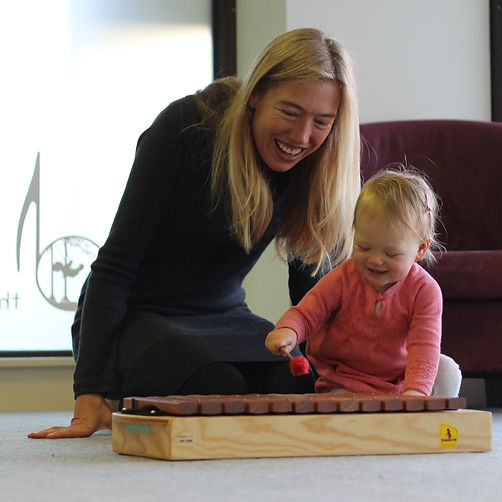
Playtime (3-6 years)
In our playtime classes, children participate in singing, movement and dance activities, playing instruments with others in a class ensemble. There are opportunities for solo and group performance and we also learn music theory including reading notation and learning musical terms and signs.
This class is designed to facilitate a smooth transition from the Small Steps class to learning any instrument, as well as extending and supporting the beginner instrumentalist by providing a social outlet for their musical endeavours. It is common for children learning the Suzuki method to begin learning an instrument around three. Children who have begun to learn an instrument continue in our Playtime class until they start school.
The activities build and develop the skills established in the Small Steps class. New songs and rhymes are introduced, many from early Suzuki book repertoire which helps the newest children with the transition from Small Steps classes to instrumental lessons.
The activities in the classes are designed to help children become more aware of the musical elements of beat, rhythm, dynamics, tempo, pitch and tone. This gives the teacher more time in the instrumental lessons to focus on specific techniques for playing the instrument. The rich musical environment of the class helps the children progress in their instrumental lessons faster and with more enjoyment.
Multi-age Classes
All our classes are taught in mixed age and ability groups. The Suzuki philosophy aims to replicate the way children learn from each other when placed in extended family groupings with multi-age children. Less experienced children notice what the other children are doing and strive to be like them. The more experienced children love to be the “big kids” and take a lot of pride in demonstrating their skills.
Each activity is carefully layered to meet the needs of children at many levels. Children respond in their own appropriate way to each task. As they become more experienced in the class they are presented with additional challenges within the activity which keeps the class stimulating and enjoyable.
Parent/Teacher Partnership
Suzuki said “Children behave the same as their parents. They absorb the actions of their parents by merely watching.” In our classes a parent/carer always attends with the child, and models the behaviour they wish to see in their children. The children will begin to imitate them. Parents are not expected to be musical; all we ask is that they are prepared to “have a go” and assist us in working with the children.
When parents participate in the class, they develop a better understanding of skills their child is learning, and are better able to support their child. This is a great opportunity to observe your child in a formal learning environment and develop a good understanding of how they learn.
We always give the parent and child a weekly task to take home and practise. Parents are encouraged to play the CDs every day in the home. Listening to good music regularly in the home enriches the children's environment as well as helping everyone to remember the songs and rhymes!



Calm Environment
In a calm, structured environment children can learn through observing others, listening and imitating more easily. We have a structured routine with an emphasis on helping children develop their emotional self-regulation skills.
Quality Instruments
Suzuki was very fond of saying “Beautiful Tone, Beautiful Heart.” We have an emphasis on creating beautiful sounds, to nurture musical sensitivity. We only use high quality instruments.
By exposing children to beautiful tone in a calm environment, they become discerning listeners very quickly.
Performance Opportunities
Children learn from the beginning that music is a performing art. In every class there are opportunities for solo and group performances using instruments as well as the voice. Children who have begun to learn an instrument are also sometimes given opportunities to perform on their instrument in the class to the other parents and children.
Instrument Readiness
It is common for children learning the Suzuki method to begin learning an instrument around three, however not all children are ready, especially if they have not come through the Small Steps programme from birth.
There are many skills that children need before they begin to learn an instrument and good preparation makes an enormous difference. The first instrumental lesson only happens once. If we lay good foundations before introducing an instrument then the likelihood of success in that first lesson is great.
Here are some of the things that we work on in the classes to help a child be ready to learn an instrument:
-
We Sing. The child that can sing in tune has a well developed ear.
-
We Move. This enhances body awareness, which is essential for playing any instrument, as well as helping children develop a sense of beat.
-
We prepare the arms, wrists and fingers. We practise our fine motor control moving them individually and together. We learn to relax and move them freely, as tension will affect good tone production on an instrument.
-
We develop a sense of beat and rhythm using songs and rhymes.
-
We learn to identify left and right, high and low.
-
We interact with others. Children who can listen, share and wait for their turn are well prepared to play music with others.
-
We learn to respect and care for instruments.
-
We practise self-regulation. This builds resilience, which really helps children to succeed, because sometimes a task will be difficult at first.
-
We listen to lots of music. The child who is familiar with the music they will learn to play, finds it much easier to learn. (This is a fundamental part of the Suzuki mother tongue approach – Children learn to speak a language because they are surrounded by it.)

%2Btransparency.png)